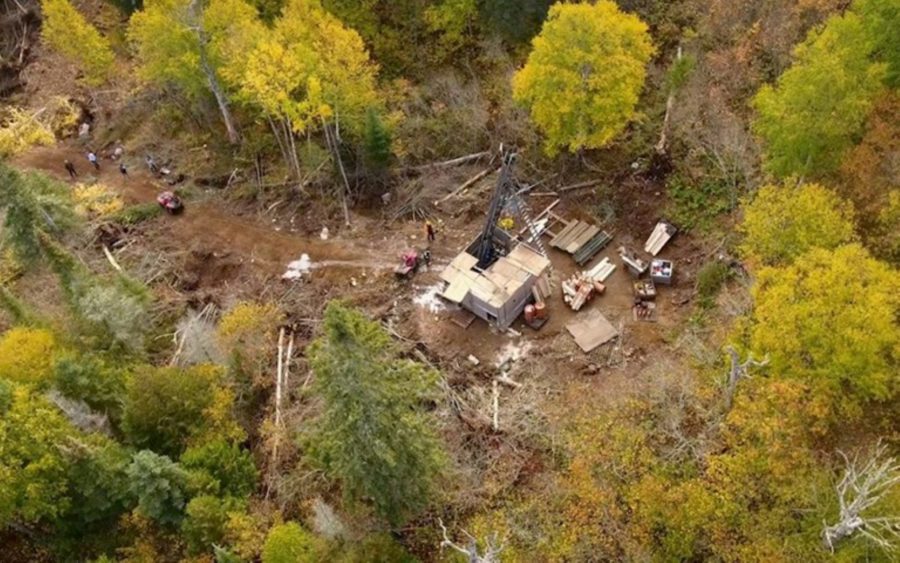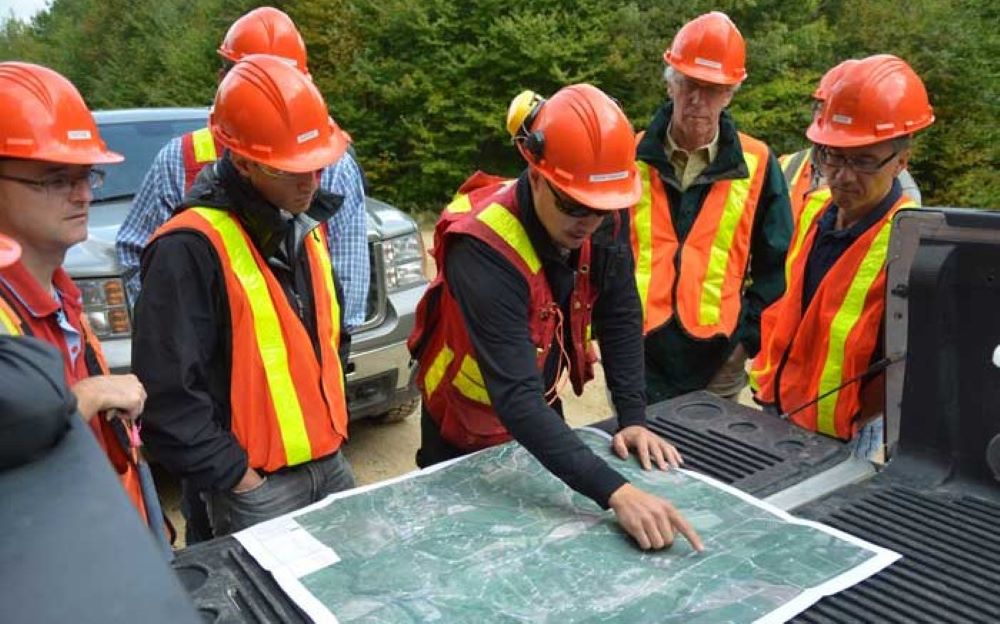Canada’s four newest gold mines
It’s been tough for the last several years to get mine financing, but these four new Canadian gold mines, all coming on stream this year, prove that it hasn’t been impossible. The challenges aren’t over once the financing is in hand or the construction is complete, however. Read how these mines are dealing with the issues – big and small – that come with working the bugs out of a new operation.
BRUCEJACK – Pretium Resources – B.C.

The Brucejack mine, 65 km north of Stewart, B.C. CREDIT: PRETIUM RESOURCES
Pretium Resources’ Brucejack mine, in B.C.’s Golden Triangle, achieved commercial production in July – only eight years after the super high grade Valley of the Kings deposit at the project was discovered.
The deposit was discovered in 2009 by Silver Standard Resources and a year later, Pretium Resources had its IPO and acquired the project. Ever since then, Pretium has been pushing hard to get the underground mine into production. In fact, the mine achieved commercial production three months early.
Even before introducing first ore to the mill in May, the company was focused on achieving name plate capacity of 2,700 t/y as quickly as possible on low grade ore. That was achieved by the end of July, and the focus for the rest of the year is now on increasing the grade of the ore in the mill.
As the grade to the mill increases the company must also optimize the gravity circuit and then the float circuit at Brucejack: both gold doré and a gold-silver concentrate are produced onsite.
“The target is to be at steady state production levels by the end of this year,” said president and CEO Joseph Ovsenek in a late August interview. “That’s a big challenge, but I think everyone’s working hard to achieve it.”
Over its first eight years, Brucejack is expected to produce 504,000 oz. of gold annually, with production averaging 404,000 oz. per year for the remaining 10 years of mine life. At base case metal prices of US$1,100 per oz. gold and US$17 per oz. silver and a 5% discount rate, a 2014 feasibility study pegged the project’s post-tax net present value (NPV) at US$1.5 billion and its internal rate of return (IRR) of 28.5%. In February, Pretium updated capital cost estimate for the mine to US$811 million – up from US$697 million previously.
The mineralization at Valley of the Kings is contained in quartz stockworks systems that vary in width from 20 to 50 metres, and typically grade 0.5 to 3 g/t gold, Ovsenek says. “Within that we have those high-grade veins where we get kilograms of gold per tonne.”
Valley of the Kings contains proven and probable reserves of 8.1 million oz. gold and 5.9 million oz. silver in 15.6 million tonnes grading 16.1 g/t gold and 11.1 g/t silver. The West Zone at Brucejack holds 600,000 oz. gold and 26 million oz. silver, hosted in 2.9 million tonnes grading 6.9 g/t gold and 279 g/t silver.
The high grade nature of the ore has led to one challenge in the mill: When the rock hits the SAG and ball mills, coarse visible gold is freed. The mills act as big centrifuges, forcing heavy gold particles to the outside, where they work their way into nooks and crannies.
In an August press release, the company revealed that a 4.7-kg grab sample taken from gravity recoverable gold trapped behind a SAG mill liner graded 23,547 g/t gold. Ovsenek says the gold will be recovered when the liners are replaced as they wear out.
To control dilution at the operation, which is being mined by longhole stoping, the company is finalizing a grade control plan that will see it sample drill cuttings from each of the blasthole rings to provide an estimated grade for each ring.
In addition, after mining out a stope, a LIDAR unit will be used to scan the stope so mined material can be compared to plan and corrective actions can be taken where necessary.
“Between those two approaches we figure we’ll have a good handle on dilution,” Ovsenek says.
In terms of innovations at the mine, Ovsenek points to work that’s gone into energy efficiency. While the mine is tied to the grid, the company has opted for little things like LED lighting and on the hightech end, variable frequency drives for the drive units in the mill building to conserve energy. The mill building also contains a state-of-the art water treatment plant.
HOPE BAY – TMAC Resources – Nunavut

The Hope Bay site. CREDIT: TMAC RESOURCES
After pouring its first gold in February, TMAC Resources declared
commercial production at the Hope Bay mine, 125 km southwest of Cambridge Bay in Nunavut, on May 15. Acquired by TMAC in 2013, the project contains three deposits: Doris, which is now being mined, Madrid, which is next to be developed, and Boston.
The underground mine is expected to produce 160,000 oz. of gold per year over a 20-year mine life at 2,000 t/d from the three deposits. A 2015 prefeasibility study pegged start-up capex at $206 million, and sustaining capital at $436 million. At a discount rate of 5% and US$1,250 per oz. gold, the study forecast the project’s post-tax NPV at $626 million and its IRR at 40%. All-in sustaining costs (AISC) are expected to be US$785 per oz. of gold, while cash costs should be under US$600 per oz.
As of December, TMAC had spent $350 million on development. The company negotiated another US$30 million in credit in July, amending an existing US$130-million loan agreement.
Mine development at Doris North has been progressing well.
However, issues in the processing plant have forced the company to take its ramp-up to full production more slowly than planned. In August, the company said it now expects to sell 50,000 to 60,000 oz. of gold this year, down from 100,000 to 120,000 oz. previously forecast.
In August, TMAC CEO Catherine Farrow said that the characteristics of the Doris ore have been in line with expectations and are not the cause of any complications in the plant recoveries.
In a conference call she explained that the plant issue is more complex than just one item.
“From where we feed the ore right through to where we refine the ore, it’s a systematic process of going through and optimizing pieces of equipment,” she said. “It’s more of just achieving stability, getting the plant very calm and running, and now systematically going through the plant and working on individual components to bring their performance up.”
Farrow said the company is first focusing on plant stability and getting it to run consistently at its design capacity of 1,000 t/d. As that’s achieved, TMAC will begin to tweak recoveries – which in June averaged only 67% compared to 90% projected in a 2015 prefeasibility study.
After it achieves steady state production of 1,000 t/d, the company will ramp up to 2,000 t/d next year. A second 1,000 t/d modular Python plant (supplied by Gekko Systems) is being delivered to the site this year.
Hope Bay currently hosts proven and probable reserves of 3.6 million oz. contained in 14.5 million tonnes grading 7.7 g/t gold.
Sixty kilometres south of Doris, TMAC has recommissioned a camp at Boston to support its first drill program there. Initial results have included a 22.3-metre interval of 15.3 g/t gold.
The three deposits at Hope Bay were discovered in the 1990s by BHP. The project has also been owned by Miramar Mining and Newmont Mining.
MOOSE RIVER CONSOLIDATED – Atlantic Gold – Nova Scotia

Moose River Consolidated site. CREDIT: ATLANTIC GOLD
Nova Scotia isn’t the first province that comes to mind when listing off top mining jurisdictions in Canada, but it’s actually a historic gold jurisdiction, says Maryse Belanger, Atlantic Gold’s chief operating officer.
“When you think about it, the first gold mining in Canada took place in Nova Scotia and that was back in the 1800s,” she says.
Those miners only went after the high grade gold in quartz veins, not recognizing that the gold extends past the veins into sedimentary rocks, Belanger adds.
When the disseminated shale hosted mineralization in the district is combined with those quartz veins, you can have 50- to 100-metre-wide bulk mineable zones that are a “no brainer” for an open pit, she says.
That pretty much describes Atlantic Gold’s Moose River Consolidated (MRC) mine, about 85 km northeast of Halifax. Over a minimum 8.5-year mine life, MRC will produce 87,000 oz.
gold per year from two open pit deposits: Touquoy and Beaver Dam.
At a gold price of US$1,200 per oz., the initial capital cost to build MRC was projected at $137.3 million at a 5% discount rate, according to a 2015 feasibility study.
Its post-tax NPV was estimated at $168 million and its IRR at 30%. The study pegged cash operating costs at C$626 per oz. and AISC at C$690 per oz.
Construction at the mine, which began in the second quarter of 2016, was 95% complete at presstime in August. Commercial production is expected in early 2018.
Atlantic has an effective 63.5% interest in Touquoy (a private company with a carried interest owns the rest) and a 100% stake in Beaver Dam, and two other nearby deposits: Cochrane Hill and Fifteen Mile Stream. The company expects to release a prefeasibility study for a second phase of mining at MRC incorporating Cochrane and Fifteen Mile Stream as satellite deposits in October. Atlantic consolidated ownership of the deposits in September 2014.
Atlantic has done a number of innovative things at Moose River. For one, it opted for a fixed-price EPC contract – unusual in the industry – to avoid the capex cost overruns that have become routine.
“What it meant was more work on the front end on the detailed engineering side and equipment selection (for the contractor) to be able to say we will build a plant for this much money,” Belanger says.
The company is also using grade-control drilling on as close as 5 by 5-metre spacing to better define ore and waste, reduce dilution, and have information sooner for planning.
“It means that up to a year and a half before we mine that material, we have that information,” Belanger says. “So we sample and assay and get that information, and it allows us to adjust our resource model, get a more robust predictive model for short-range planning.” As part of the grade-control drill program, Atlantic is the first company in North America to have a PAL (pulverize and leach) machine in the lab, a piece of equipment that allows it to analyze up to fifty 1-kg samples at once.
“With a disseminated deposit, you want a representative sample,” Belanger says. “Instead of doing what’s standard in the industry, a 30 or 50-gram fire assay, we assay a full 1 kg.” In addition, as grinding typically accounts for 30-40% of the operating cost in processing, the company is paying attention to energy efficiency.
Belanger is also implementing a mine-to-mill program to optimize fragmentation in the mine.
RAINY RIVER – New Gold – Ontario

The Rainy River mine in Ontario. CREDIT: NEW GOLD
New Gold is an intermediate producer with several mines already in its portfolio.
New Gold bought the Rainy River gold project, 65 km northwest of Fort Frances, Ont., in 2013. Slated for first production in September and commercial production in November, Rainy River will be the company’s fifth mine.
With a 14-year mine life, the open pit and underground operation is expected to produce 325,000 oz. a year over its first nine years at a rate of 21,000 t/d.
Proven and probable reserves total 3.8 million oz. gold and 9.4 million oz. silver in 104.3 million tonnes grading 1.13 g/t gold and 2.81 g/t silver.
A 2014 feasibility study on Rainy River used base case prices of US$1,300 per oz. gold, US$22 per oz. silver and an exchange rate of US$0.95.
At a discount rate of 5%, the post-tax NPV was estimated at US$314 million and the IRR at 11.3%.
Cash costs were pegged at US$663 per oz., AISC US$765 per oz. and the preproduction capex at US$885 million.
The project hasn’t gone completely according to plan, however. In January, the company announced that first production would be delayed by three months (to September), and that the project would cost another $195 million due to a slower than planned ramp-up in mining rates. Layers of peat and basal till encountered during open pit development slowed production, with the company having to spend more on equipment and contractors. New Gold had already added another $125 million to costs last September, associated with a redesign of the project’s tailings management facilities.
Management changes and a revised plan for Rainy River in January, along with a US$173-million financing in March, may have put the mine back on track.
And on a second-quarter conference call, president and CEO Hannes Portmann pointed out that after spending US$515 million this year on Rainy River, the mine will soon go from consuming cash to generating it.
The company has applied for a Schedule 2 amendment needed to close off two small creeks within its tailings management facility, and expects to receive it in the final quarter. In the meantime, a starter tailings cell, expected to be completed in August, will allow for about six months of production.





Comments